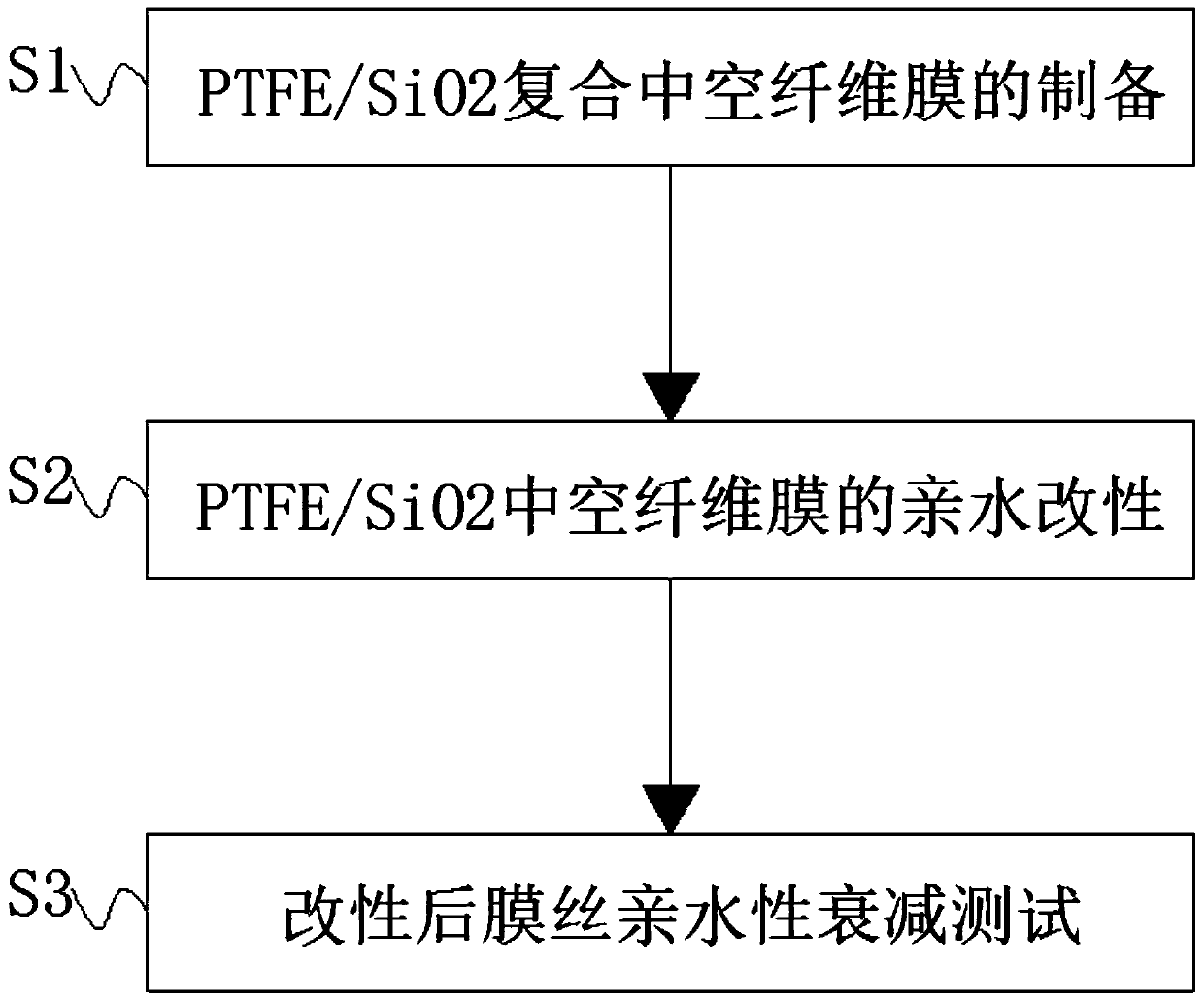Preparation method of hydrophilic polytetrafluoroethylene hollow fiber membrane
A technology of polytetrafluoroethylene and fiber membranes, which is applied in the field of preparation of hydrophilic polytetrafluoroethylene hollow fiber membranes, can solve the problems of destroying the structure of the membrane body, complicated operation steps, and a large amount of harmful waste liquid, and expand the scope of application , Improve product advantages, improve the effect of hydrophilic performance
- Summary
- Abstract
- Description
- Claims
- Application Information
AI Technical Summary
Problems solved by technology
Method used
Image
Examples
Embodiment 1
[0025] S1, PTFE / SiO2 2 Preparation of composite hollow fiber membrane: adding 0.25% nano-SiO to the original formula of PTFE 2 Particles, after being uniformly mixed in a mixer, compacted, pushed, stretched, and sintered to obtain PTFE / SiO 2 Composite hollow fiber membrane;
[0026] S2, PTFE / SiO2 2 Hydrophilic modification of hollow fiber membranes: the PTFE / SiO obtained in step S1 2 The hollow fiber membrane is soaked in a 1% PVA aqueous solution mixed with a certain amount of coupling agent. After soaking for 1 hour, the membrane filaments are taken out and dried, and then soaked in a GA aqueous solution with a concentration of 2%. After 1 hour, the membrane filaments are taken out and dried. Dry to get hydrophilic PTFE / SiO 2 Hollow fiber membrane, the contact angle of the PTFE hollow fiber membrane without hydrophilic modification and water is 138 °, the hydrophilic PTFE / SiO obtained through this embodiment 2 The contact angle between the hollow fiber membrane and wate...
Embodiment 2
[0029] S1, PTFE / SiO2 2 Preparation of composite hollow fiber membrane: adding 0.5% nano-SiO to the original formula of PTFE 2 Particles, after being uniformly mixed in a mixer, compacted, pushed, stretched, and sintered to obtain PTFE / SiO 2 Composite hollow fiber membrane;
[0030] S2, PTFE / SiO2 2 Hydrophilic modification of hollow fiber membranes: the PTFE / SiO obtained in step S1 2 The hollow fiber membrane is soaked in a 1% PVA aqueous solution mixed with a certain amount of coupling agent. After soaking for 1 hour, the membrane filaments are taken out and dried, and then soaked in a GA aqueous solution with a concentration of 2%. After 1 hour, the membrane filaments are taken out and dried. Dry to get hydrophilic PTFE / SiO 2 Hollow fiber membrane, the contact angle of the PTFE hollow fiber membrane without hydrophilic modification and water is 138 °, the hydrophilic PTFE / SiO obtained through this embodiment 2 The contact angle between the hollow fiber membrane and water...
Embodiment 3
[0033] S1, PTFE / SiO2 2 Preparation of composite hollow fiber membrane: adding 1% nano-SiO to the original formula of PTFE 2 Particles, after being uniformly mixed in a mixer, compacted, pushed, stretched, and sintered to obtain PTFE / SiO 2 Composite hollow fiber membrane;
[0034] S2, PTFE / SiO2 2 Hydrophilic modification of hollow fiber membranes: the PTFE / SiO obtained in step S1 2 The hollow fiber membrane is soaked in a 1% PVA aqueous solution mixed with a certain amount of coupling agent. After soaking for 1 hour, the membrane filaments are taken out and dried, and then soaked in a GA aqueous solution with a concentration of 2%. After 1 hour, the membrane filaments are taken out and dried. Dry to get hydrophilic PTFE / SiO 2 Hollow fiber membrane, the contact angle of the PTFE hollow fiber membrane without hydrophilic modification and water is 136 °, the hydrophilic PTFE / SiO obtained through this embodiment 2 The contact angle between the hollow fiber membrane and water i...
PUM
| Property | Measurement | Unit |
|---|---|---|
| water contact angle | aaaaa | aaaaa |
Abstract
Description
Claims
Application Information
 Login to View More
Login to View More - R&D
- Intellectual Property
- Life Sciences
- Materials
- Tech Scout
- Unparalleled Data Quality
- Higher Quality Content
- 60% Fewer Hallucinations
Browse by: Latest US Patents, China's latest patents, Technical Efficacy Thesaurus, Application Domain, Technology Topic, Popular Technical Reports.
© 2025 PatSnap. All rights reserved.Legal|Privacy policy|Modern Slavery Act Transparency Statement|Sitemap|About US| Contact US: help@patsnap.com

